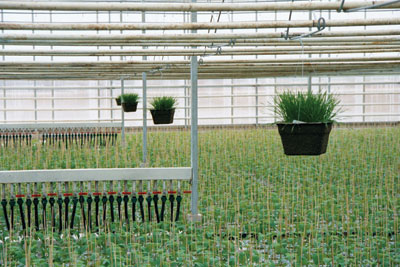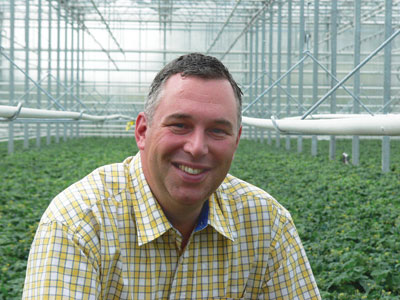
Clean cuttings, young plants or plugs… this has been a discussion point for many years in our industry.
Clean cuttings, young plants or plugs… this has been a discussion point for many years in our industry. It has also been a source of tension, at times, between customers and suppliers. In this article, my goal is to present some positive views – and hopefully, as a result, spark some positive dialogue – about this topic among growers, propagators, breeders and industry technical support people.
 |
|
| Aphid banker plants for aphid control. Advertisement
|
Learning from the past: The greenhouse vegetable industry has gone through this situation before, but it was at least two decades ago.
I grew up in the greenhouse vegetable industry in the Netherlands and my parents owned and operated a six-acre hydroponic tomato production greenhouse.
When my father took over from my grandfather in 1966, the meaning of a “clean” plant was very different from what it is today. A “clean” plant then was a plant that had no bugs (what is still called “zero tolerance” today). My father implemented biological control for the first time in 1971 to control whitefly in his tomato crop. The reason for this switch was the pesticide resistance affecting the vegetable industry at the time.
In those early years, implementing biocontrol in vegetables wasn’t always easy and it was often hard to discover why things didn’t work out the way they were supposed to. The keys to success were found by trial and error, and they included such things as commitment, starting early in the crop cycle, monitoring, management from beginning to end of the crop, and not to forget… patience.
Something common back then was the early release of biological control agents (BCAs), in this case Encarsia formosa for whitefly, in the crop. This was more or less done on a preventive basis; even if whitefly had not yet been seen, it didn’t mean they were not present.
Greenhouse vegetable growers in the Netherlands were getting their young plants started by specialized propagators, and plants would arrive at the greenhouse at about six weeks of age. Of course, these plants needed to be “clean.” However, it quickly became evident that “clean” wasn’t always completely “clean.” Plants would still come in with pests present. But not only that, the plants had also been sprayed with many non-compatible pesticides that have residual effects on BCAs, some of them having long residual effects.
In those years, products such as oxamyl (vydate), methomyl (lannate), endosulfan (thiodan) and acephate (orthene) were still registered for use in vegetable crops in the Netherlands. Needless to say, this was in many cases a major challenge for biological pest management programs.
Within a few years, an understanding was established between propagators and their customers about pest management and what a “clean” young plant would or should be.
The words “zero tolerance” disappeared as it became clear that having low pest levels and no long-residual pesticides was a better option than having low pest levels and long-residual pesticides, which basically meant the grower has a hard time getting his biological pest management program started. It was basically determined that “zero tolerance” is extremely hard, if not impossible, to achieve and that using an arsenal of pesticides does not guarantee a plant will be free of pests!
Today, most vegetable propagators are working with an IPM program, which involves using BCAs as a first line of defence. That doesn’t mean they never use a pesticide, but if they do, it is BCA-compatible, or at worst, a pesticide that does not have a long negative residual effect. With this technique, they are not only leaving the customer (grower) with plants on which BCAs will start successfully, but they are also doing their part with the issue of pesticide resistance management since there is very little pesticide usage.
HOW CAN WE APPLY THIS TO THE ORNAMENTAL iNDUSTRY?
As many of us know, pesticide resistance has been experienced during the last few years in the ornamental industry, and especially with thrips and two-spotted spider mites. This has happened not only here in Canada, but in other countries. Due to the global trade of plant material, if pesticide resistance shows up somewhere, within a very short time it is transported around the world. This pesticide resistance has been a motivator for ornamental greenhouse growers to look at alternatives for pest management, just like their vegetable grower colleagues did in the 1970s and 1980s.
 |
|
| IPM specialist Ronald Valentin; biocontrol in vegetable propagation
|
The use of biological control is increasing in the ornamental industry on a worldwide basis, too. There are many growers who are very successful, but just as the vegetable growers had to go through a learning curve, so did we in the ornamental greenhouse industry over the last several years, and this will probably continue for several years. There is, however, one similar issue in the ornamental industry that the vegetable growers faced more than 20 years ago – the need for “clean” propagation material, including rooted and unrooted cuttings.
In a recent study done at the University of Guelph, five main varieties of chrysanthemums were checked for the presence of thrips when they arrived from breeders. This study went on for eight months and every two weeks samples were taken. Not one sample came in as “clean” – in all samples, adult and immature thrips were found. In some samples, one adult thrips in every two cuttings was present. This is obviously a challenge, but what was even more of a concern was the arsenal of pesticides that had been applied to the stock plants. This meant it was likely these thrips were highly resistant to many pesticides. The growers involved in this project work with BCAs as part of their pest management and the fact these cuttings were not “clean” in more than one way was troublesome.
MAJOR ORNAMENTAL STUDY UNDERWAY IN THE NETHERLANDS
In the Netherlands, a three-year project was started in 2010 to address this issue of “clean” cuttings. In this project, the objective is to determine pesticide residues on cuttings of different crops coming in from different parts of the world as well as from within the country. This project has been initiated because these residues are “suspected” of being the main reason BCAs have not been as successful as expected after their introduction into various crops.
The potted plant sector took 39 samples in 2010. In these 39 samples, they found 302 pesticide residues; of these, 115 were compatible products, 55 needed to be considered individually as they were compatible with some BCAs and not with others, and 132 were not compatible products.
The other question about these non-compatible pesticides is how long would it take until the residue is low enough or completely eliminated so BCAs can get to work. I am sure we will learn much more about this project within the next few years.
PROGRESS ON MORE BCA-FRIENDLY PROGRAMS
Some breeders and propagators (rooting stations) have already implemented more BCA-friendly pest management programs. However, in an ideal world, it would be great if the ornamental industry could skip the mistakes made by our vegetable counterparts and implement a more BCA-friendly pest management strategy with all propagators and breeders.
However, sometimes as an industry, we are our own worst enemy. A grower asking for a credit because he did not receive “zero tolerance” on his cuttings or plugs does not solve anything in the long run. The bigger question is how can we minimize initial pest levels and long-residual pesticides on propagative material.
The use of a pest management program at the level of breeders and propagators that includes BCAs, not excluding some short-residual and compatible pesticides, will benefit the industry. This will not only benefit growers who are working with BCAs in their pest management program, but also growers who are working with traditional pesticides and are not yet ready to implement BCAs, as these techniques are an excellent pesticide resistance management tool.
The key here is that propagative material coming out of a pest management program that excludes the long-residual pesticides leaves the option open for the grower to implement BCAs or a traditional pesticide program. Propagative material that includes a whole arsenal of pesticides and still has pesticide-resistant pests makes it more difficult for the grower to make any pest management program work.
MEASURES TO MAKE AS CLEAN A START AS POSSIBLE
Of course, it is always important to inspect incoming propagative material for the presence of pests, but it is unrealistic to expect “zero tolerance” results. It’s a good idea for growers to be informed about all the pest management tools and products used during propagation, because this will let them know what to expect from BCAs if released early on. This would also help growers using traditional pest management programs choose their pesticides more wisely.
We’re still not sure what is acceptable and not acceptable as far as pest levels go. For example, unrooted poinsettia cuttings will have some whitefly issues, but if every cutting has as many as six adult whitefly, as I observed last July, then there is obviously a problem.
To reduce the level and risk of pests coming in through the door, many growers and propagators have started to treat rooted and/or unrooted cuttings with products such as Botanigard, biological fungicides such as Rootshield, and the nematode Steinernema. Treating cuttings before they enter the greenhouse will not eliminate pest problems, but certainly will reduce the numbers and the risk.
For example, the study at the University of Guelph has shown excellent results on thrips adults and immatures, but it does very little on the eggs of thrips as they are protected in the plant tissue. But if you eliminate most adults and immatures, it will lower the total number of thrips, and it also buys the grower – and the BCAs – some time if pesticide residues are an issue.
Products such as nematodes and Botanigard work only by contact, so dipping is the best way of getting optimal coverage. However, there is some risk with dipping cuttings as most plant pathologists will say that disease problems could be an issue. It is for each individual grower to assess that risk and see which is a greater risk. Sprenching the products mentioned above will definitely have some effect as well, but dipping makes avoiding contact with the solution very difficult.
In the study at the University of Guelph, hot water treatments have been successful on thrips. Thirty minutes at 102.2ºF (39ºC) or 15 minutes at 104ºF (40ºC) gave excellent results on chrysanthemum cuttings without any phytotoxicity or plant damage. This, however, is not a guarantee, nor has it been tested on other plant species. As well, horticultural oil was very good in reducing both thrips and whitefly populations, but it currently does not have a registration to be used as a dip treatment.
The above treatments have no residual effect on BCAs. They are not exclusive to growers who are using BCAs as part of their pest management program, but can be implemented in any pest management program.
I wish everyone a very successful and “clean” growing season.
Ronald Valentin is a biological control and IPM specialist with Biobest Biological Systems. • RValentin@biobest.ca
Print this page